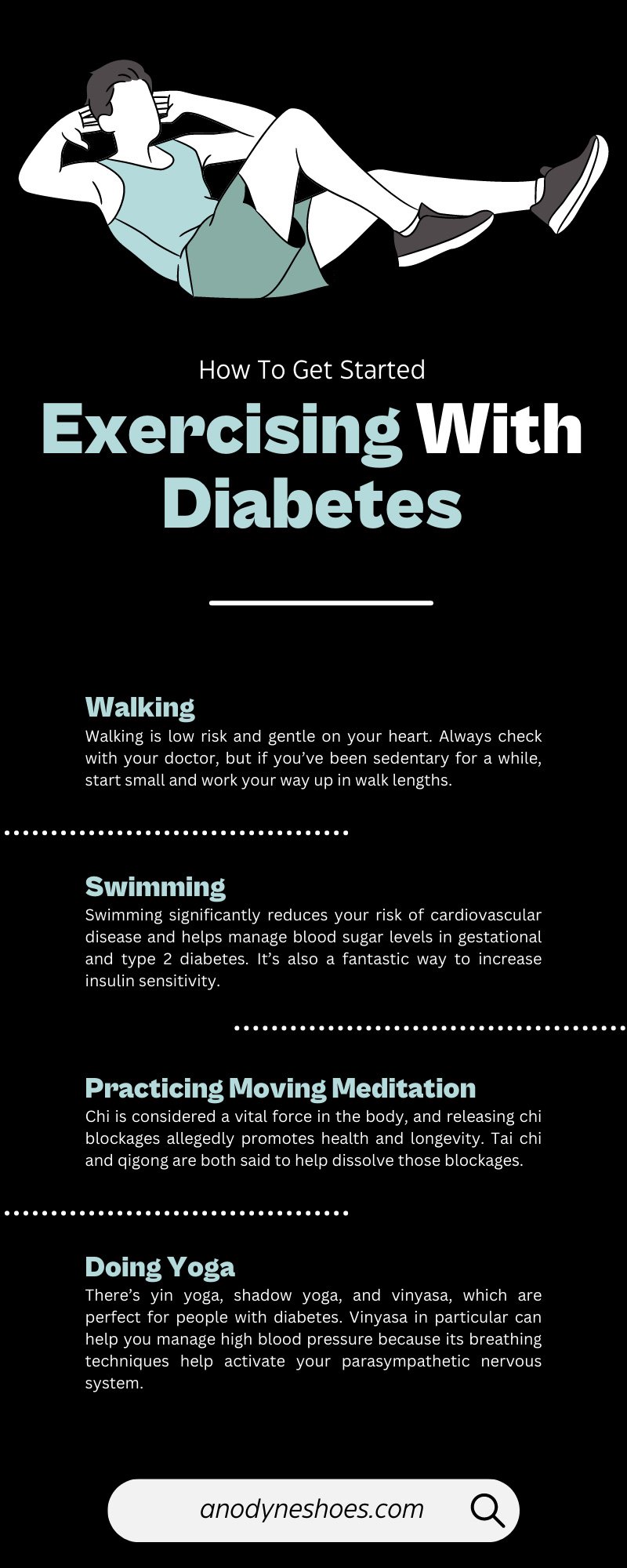%20(750%20x%20422%20px)%20(17).jpg?width=750&height=422&name=Anodyne%20Blog%20Template%20(1080%20x%201080%20px)%20(750%20x%20422%20px)%20(17).jpg)
If you have diabetes, exercise should be a key aspect of your health regimen, along with measuring your blood sugar and managing your meals. However, exercise can be difficult to maintain, and it’s a far more nuanced topic than you’d think, especially when layered with diabetes-related complications. Check out our tips to start exercising with diabetes below.
Speak to Your Doctor
The first thing you need to do when you’re ready to exercise with diabetes is loop in your healthcare team. You’d be surprised how many people want to begin moderate to intense exercise without any outside consultation.
Your doctor can create an exercise plan for you, tell you more about diabetic patches you can wear during exercise, and provide you with the perfect brand of diabetic shoes. They can also check things like your A1C—long-term blood sugar rating over months—and other important numbers you need to know on your fitness journey. For all these benefits, consulting your trusted medical providers should be the first thing you should do when you start exercising with diabetes.
Figure Out How Exercise Can Change Your Medication Requirements
You’ll experience muscle contractions when you exercise, and your body will demand energy to accommodate these contractions. This energy comes from glucose. The more exercise you do, the more glucose you’ll burn, which helps lower your blood sugar. Therefore, insulin works far better when you’re physically active.
However, you might need to adjust your medications and diet for your exercise routine to prevent hypoglycemia. This is why our previous point about talking to your doctor is so important. They’ll be able to give you a heads-up on medication changes and any other adjustments you need to make.
Understand What Might Be Stopping You
Finally, figuring out what might be stopping you from quitting your sedentary lifestyle is important. For some people, it might just be the initial unpleasantness of exercising that they have to overcome, especially if they’ve lived mostly sedentary lifestyles for a long time. Your heart will beat, your blood will pump, and your muscles will likely burn. That said, we guarantee you’ll feel much better after you get over that initial hump, and you’ll want to exercise again and again. You might want to start slowly if you’re older, but you must start. If you feel like the results take too long, know that some benefits are just around the corner, even if it doesn’t feel obvious to you. And of course, the long-term benefits will be amazing.
Learn How To Stay Motivated
Considering how exercise will help you in the long run is important. Think about the “finished product.” You’ll have more stamina, feel healthier overall, and be able to manage your blood sugar levels as they fluctuate around the normal range. Who wouldn’t want these results? Know that exercising will make you feel like you have a new body. Who doesn’t want to feel like their best self and live in their full physical capacity?
Get Familiar With Different Kinds of Exercises
Now you understand why exercising with diabetes is important and have the tools to motivate and prepare you for a safe, fruitful health journey. Below, we’ll go over the numerous kinds of exercises that are perfect for people with diabetes. Read on for their descriptions and benefits.
Walking
People have been taking walks since we first walked on two legs out of the jungles of Africa millions of years ago. It’s also the easiest activity to start when first learning to control your blood sugar. Walking is low risk and gentle on your heart. Always check with your doctor, but if you’ve been sedentary for a while, start small and work your way up in walk lengths. You can even stop if you need to by taking a break on a park bench or whatever else is available where you are exercising.
Swimming
Swimming is a perfect, low-impact exercise for people who live with diabetes. Swimming significantly reduces your risk of cardiovascular disease and helps manage blood sugar levels in gestational and type 2 diabetes. It’s also a fantastic way to increase insulin sensitivity. This exercise also reduces your A1C significantly, so you and your doctor will surely get a surprise when he checks up on you after regular swim sessions.
Practicing Moving Meditation
Meditation doesn’t necessarily have to occur seated. Certain moving meditation methods like tai chi and qigong are perfect for lowering blood sugar levels and mitigating stress. According to the Annuals of Chinese Traditional Medicine, qigong and tai chi enhance a substance called chi in the body. Chi is considered a vital force in the body, and releasing chi blockages allegedly promotes health and longevity. Tai chi and qigong are both said to help dissolve those blockages. We know this sounds unconventional, but movement and stress relief are central to health, and these practices can provide these benefits, assisting you in controlling your blood sugar.
Doing Yoga
Yoga is also a form of moving meditation. Not only does yoga make the body more flexible and supple, but it also strengthens the limbs without straining them. If you want, you can branch out. There’s yin yoga, shadow yoga, and vinyasa, which are perfect for people with diabetes. Vinyasa in particular can help you manage high blood pressure because its breathing techniques help activate your parasympathetic nervous system. This parasympathetic response brings your body into a rest-and-digest mode and keeps you stress-free throughout the day.
You can go to a yoga studio if you want some positive social pressure or even do it at home. Ultimately, yoga is an extraordinarily flexible activity—pun intended—and can greatly help you in the long run.
Running
Running is a great way to enhance your health. That said, it’s important to start with walking unless you’re used to running already. Take it slow. Ensure you have your blood sugar monitor, lancets, and strips. Also, get a comfy pair of orthopedic shoes with nice insoles.
As you run, stop to take your blood sugar if you feel dizzy, lightheaded, or queasy. Diabetic patches work wonderfully to get you a second-by-second view of blood fluctuations in the app, so it might help to ask your doctor about those. In short, if you’re going to run, be prepared, pack well, and have fun!
If you need diabetic footwear to support your newly active lifestyle, we have exactly that at Anodyne! We stress quality and masterful craftsmanship in all our products, so make sure to check us out. With Anodyne, you can find the perfect pair of men’s diabetic shoes and women’s diabetic shoes, along with helpful accessories. Contact us today for more information!



.png?width=116&name=Anodyne_circle_1_logo%20(2).png)
